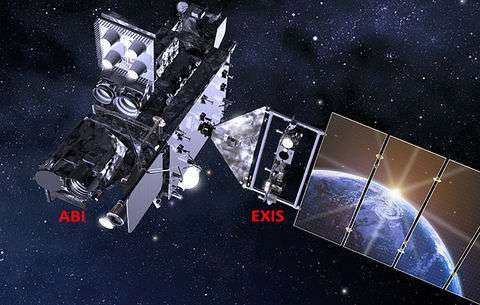Keeping a sharp eye on the environment from space

On Nov. 19, 2016, America's most advanced weather satellite rocketed into orbit carrying six new, state—of-the-art instruments, dramatically enhanced observation capabilities, and some crucial NIST calibrations.
(Geostationary Operational Environmental Satellite-R Series) is the first in the latest generation of GOES environmental satellites, operated by NOAA in collaboration with NASA. When it finishes its shakedown period, GOES-R will be able to scan the planet five times faster and with four-fold higher resolution than any of NOAA's other satellites, track regional weather events with images updated as often as every 30 seconds, and continuously record the frequency and location of lightning strikes. It will also monitor space weather that can disrupt performance of navigational and communications satellites, as well as commercial aircraft routes and the nation's power grid.
But before they could be approved for launch, GOES-R's highly sensitive sensors and imagers had to be calibrated and tested to prove that they could perform to the demanding mission specifications. NIST scientists played a key role in that process, as they have done for other satellites over the past three decades.
The Advanced Baseline Imager (ABI) is the main instrument on GOES-R (renamed GOES-16 when it reached geostationary orbit at the end of November) for observing weather, oceans, and the environment. The radiometer—which measures wavelengths and intensities of light coming from the Earth's surface and atmosphere—records in 16 different wavelength bands from infrared radiation to visible light. (The current GOES imager tracks five bands.) Because each kind of weather or environmental condition has its own distinctive wavelength signatures, the ability to distinguish three times as many bands will provide an unprecedented level of data for imaging storms as well as fire, smoke, aerosols, air quality, floods, the health of vegetation, and much more.
NIST scientists have been involved with NASA, NOAA, and contractors in the ABI project for more than 10 years, from initial development of specifications to the calibrations prior to launch. For the final stages of the process, staff from various parts of NIST's Sensor Science Division traveled to the facilities of instrument contractor Harris in Fort Wayne, IN, and Rochester, NY, often for weeks at a time.
Testing and calibrating the ABI required multiple procedures to ensure that the wavelengths and intensities recorded on the satellite sensors are accurate and traceable to NIST and thus to the International System of Units (SI). Doing so entails comparing the ABI readings to precisely known light source instruments and standards.
Some of this was done with portable NIST-calibrated radiometers; some was done at NIST, including tests of filter transmittance. Much was provided by a traveling version of NIST's tunable, narrow-wavelength source facility called Spectral Irradiance and Radiance Responsivity Calibrations Using Uniform Sources (). SIRCUS employs continuously tunable lasers coupled into hollow enclosures called integrating spheres as sources to test the response of sensors to uncertainties as low as 0.1%.
NIST was also involved in calibration of the ABI infrared bands, using a portable cryogenic radiometer (the , TXR) for a 3-week test in a vacuum chamber in Rochester. NIST staff measured the infrared standard (IR) source (a blackbody infrared source) to ensure that it agreed with the NIST scale.
Many of the GOES bands are comparatively narrow. Band 1, the blue visible band, important for detecting smoke and aerosols, only covers wavelengths from 450 nm to 490 nm. Band 3, the "veggie" band, which detects the state of vegetation as well as daytime clouds, fog, aerosols, and fire and flood potential, extends over a similarly narrow range from 846 nm to 885 nm. Band 4, the "cirrus" band, covering near-IR at 1360 nm to 1380 nm, is particularly sensitive to high, thin cirrus clouds. The required degree of accuracy in sensor response depends on the goal of the observation.
"The SIRCUS measurements resolved a discrepancy between modelled and measured band center wavelengths and bandpasses in favor of the modelled results," says NIST scientist Steve Brown, who performed many of the measurements.
Another key instrument aboard GOES-R is the Extreme Ultraviolet/X-ray Irradiance Sensors (EXIS), which tracks variations in the Sun's high-energy radiation that directly impact conditions in Earth's upper atmosphere, affecting radio transmission and changing the temperature and electrical properties of the air at altitudes above 85 km. It also monitors radiation caused by events such as solar flares. Those measurements help provide warnings of periodic storms of charged particles that blow off the Sun and can threaten the quality of global communications, the GPS system, and other essential orbiting resources.
EXIS was calibrated using NIST's Synchrotron Ultraviolet Radiation Facility () in Gaithersburg, MD, as an absolute calculable source of extreme ultraviolet (UV) and "soft" x-ray beams. Designed and built at The University of Colorado's Laboratory for Atmospheric and Space Â鶹ÒùÔºics (LASP) , the EXIS instruments were calibrated across a range of wavelengths and intensities within a vacuum enclosure at the end of a SURF III beamline. Working with NIST staff, it took EXIS lead scientist Frank Eparvier and his team from LASP about six weeks to complete the work.
SURF III is frequently used to test and calibrate sensors for space missions because it is an absolutely accurate source of radiation at specific wavelengths (with uncertainties lower than 1% in the range from 4 nm x-rays to 400 nm UV), and has a linear output that can be varied over 11 orders of magnitude in intensity. Checking the linearity of the EXIS over a large range is important. "For example, during the 11-year solar cycle, UV radiance can change by a factor of 100," says Thomas Lucatorto, leader of the Ultraviolet Radiation Group in NIST's Â鶹ÒùÔºical Measurement Laboratory.
Provided by National Institute of Standards and Technology





















